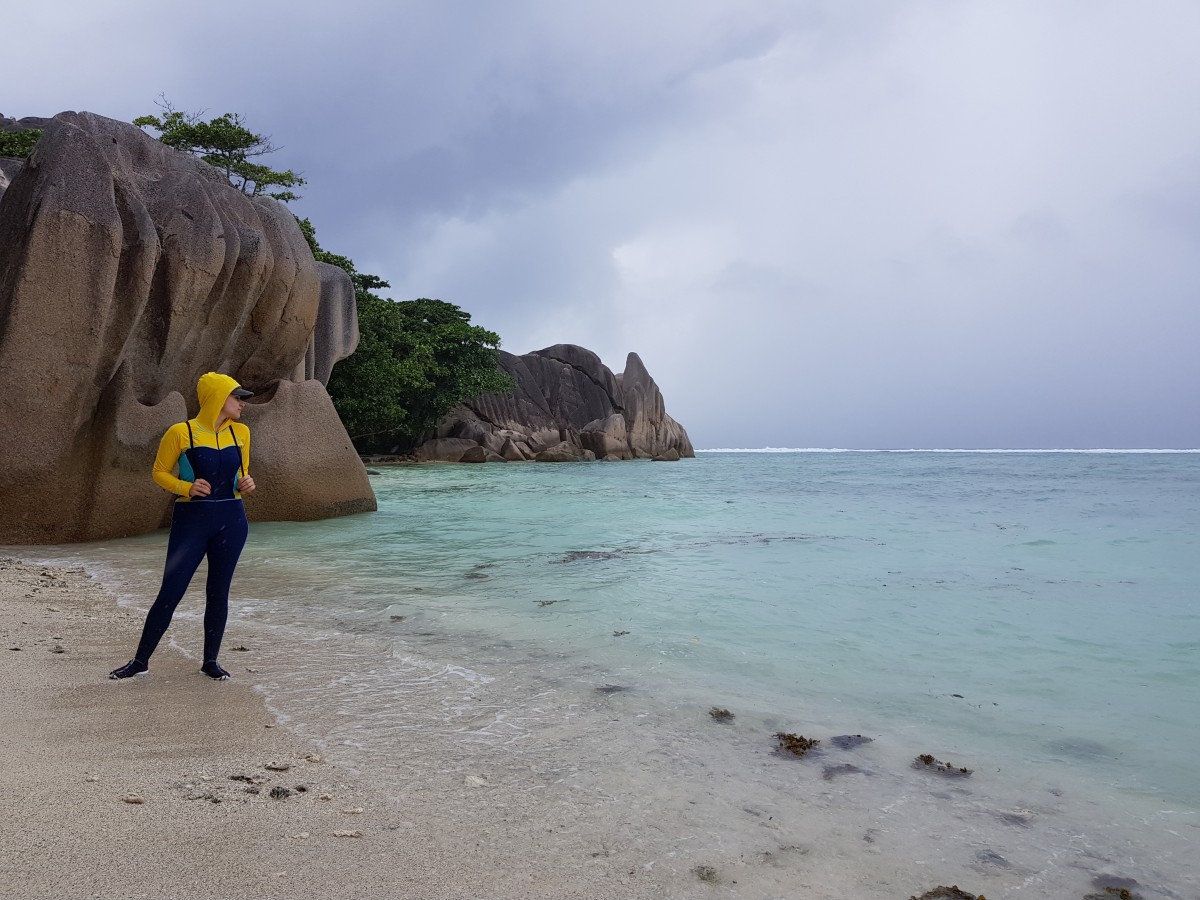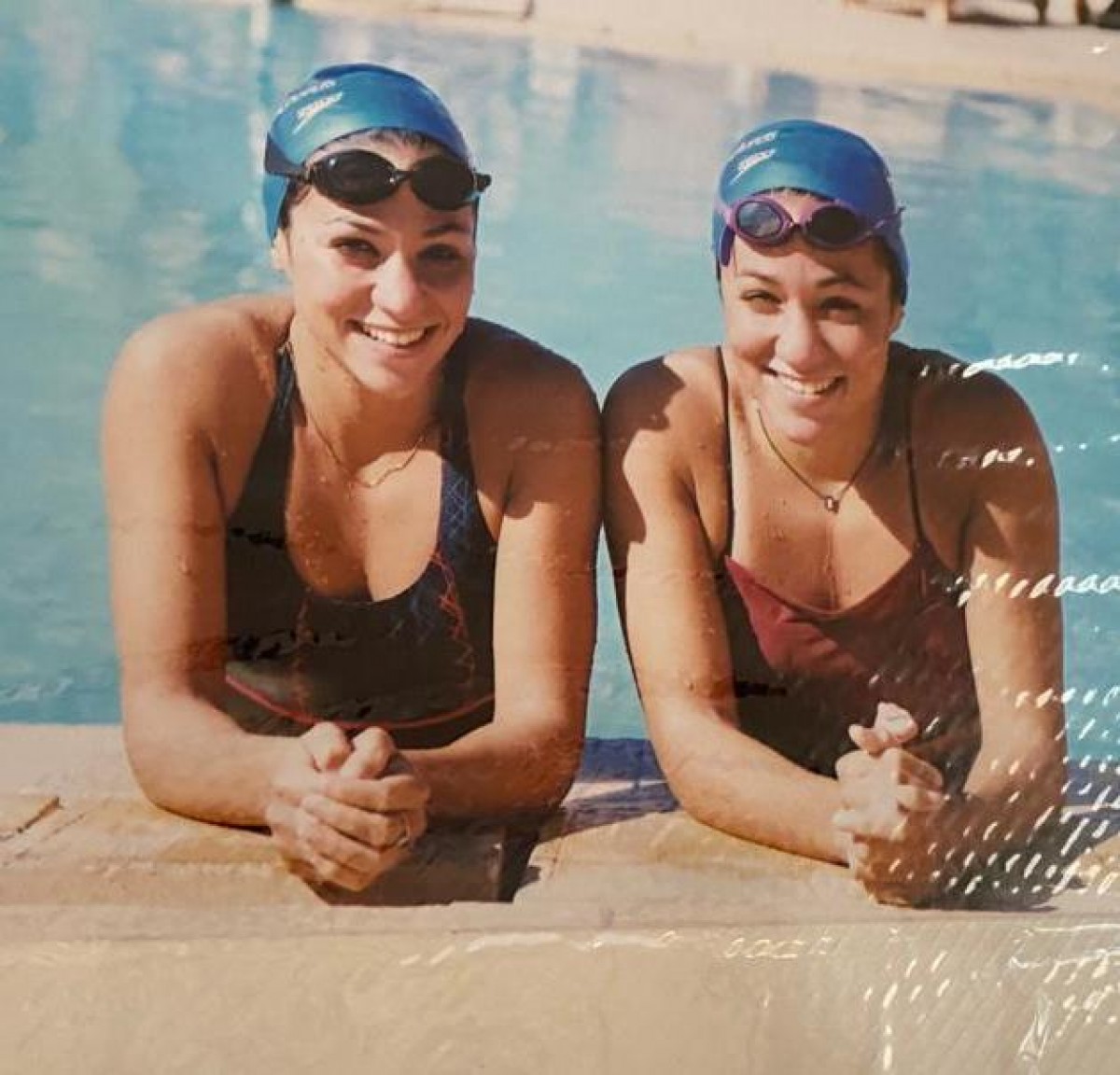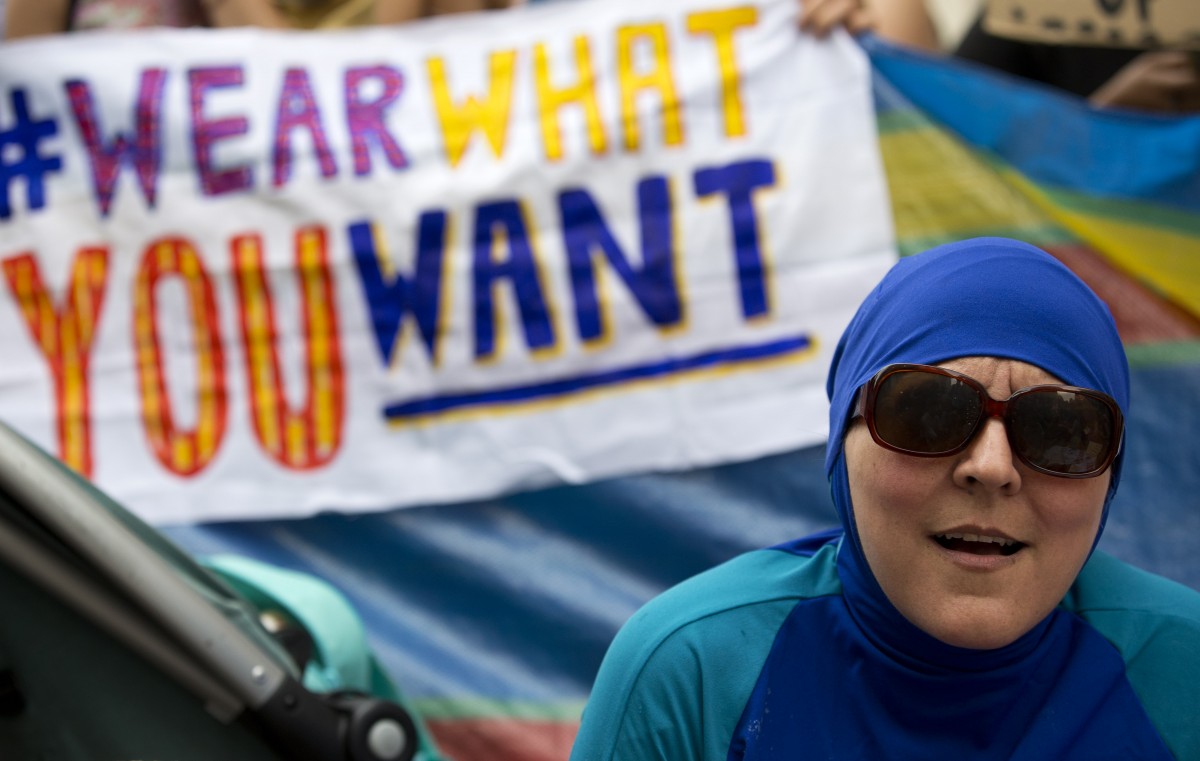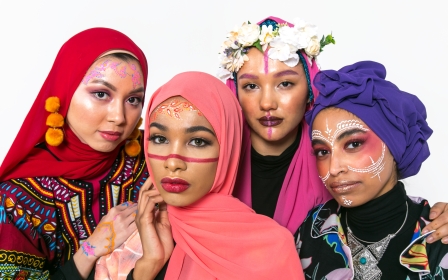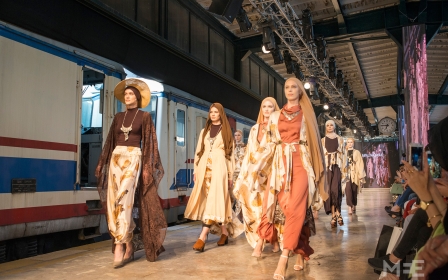Beyond the burkini: How there's more to modest swimwear than meets the eye

Swimwear selection can be a source of great anxiety for many. Finding a way to cover the body in ways that respect personal values and style is a common dilemma, especially among Muslim women - whether they have chosen to wear the hijab, or simply prefer to dress in more “modest” fashion.
But dressing modestly is subjective: when it comes to swimwear it may mean wearing a one-piece swimsuit instead of a bikini, or it could mean wearing a sarong or a wrap around the waist. For others it may mean concealing more of the body’s contours.
Modest fashion - clothes designed to conceal rather than reveal - is now a $283bn industry, projected to grow to $402bn by 2024. And it caters for every occasion, from evening gowns, to sportswear, to what to wear at the beach.
Often cited as the doyenne of modest swimwear, Aheda Zanetti created the now infamous burkini in 2004. The Lebanese-Australian mother designed the two-piece garment, similar to a full-body wetsuit in its coverage, with her young niece and daughters in mind, whom she didn’t want to miss out on swimming in Australian waters.
New MEE newsletter: Jerusalem Dispatch
Sign up to get the latest insights and analysis on Israel-Palestine, alongside Turkey Unpacked and other MEE newsletters
"I wanted my girls to grow up to have that freedom of choice," she said in an interview. "I don't care if they want to have a bikini. It's their choice.”
Although the burkini was popularised by Muslim women, Zanetti said she wanted the outfit to offer a collective experience of swimming rather than be limited to only Muslims. Jewish and Christian women have also developed their own swimwear deemed to be modest.
American actress Jessica Grey, a practising Catholic, launched her own line of modest swimwear after she publicly spoke about the decline of a modest dress code. “Modesty isn’t about covering up our bodies because they’re bad, modesty isn’t about hiding ourselves, it’s about revealing our dignity,” she said
To cover or not to cover
And, of course, health is also an ever-growing concern. Former investment banker Lisa Moore launched her brand Cover after she became frustrated by the lack of sun-protective swimwear options for her and her children. The outfits she produces are made of swim jersey fabric with UFP50+ protection.
Cover was also one of the brands modelled by the Somali-American model Halima Aden for her Sports Illustrated magazine spread in 2019.
And it was one of Aden’s outfits that former English language lecturer Alla Kwieder chose when she rediscovered her relationship with the sea, having given up on swimming for 13 years.
Growing up in Cambridge in the UK, Kwieder used to swim at every opportunity and could often be found on weekends and after school swimming laps at the local pool.
'Today you see all different types of swimwear in UK pools, but back then, in the 90s, you didn’t'
- Alla Kwieder
Since she was “brought up with modest-wear awareness” she would wear a leotard (a long sleeved one-piece), or diving shorts and a vest to swim, never a bikini. As her body started to change with adolescence, Kwieder wore the hijab in accordance to her Islamic beliefs, and also adapted her swimwear choices.
“I started wearing leggings and a vest, with a T-shirt over it, but I remember back then, T-shirts weren’t allowed for health and safety reasons, the material would retain water and pull a swimmer down," she said. "Today you see all different types of swimwear in UK pools, but back then, in the 90s, you didn’t.”
Limited swimwear options combined with not wanting to draw attention to herself put an end to Kwieder’s pool sessions. She remembers “feeling uncomfortable” and said, “walking in [to the swimming pool] was like trying to prove a point that you’re choosing not to blend in, because you didn’t look like the mainstream public.
“I just gave up,” added the 36-year old British Syrian, who now lives in Riyadh. “I genuinely loved it… balancing my body in water, which is actually how I taught myself to swim. It was eliminated from my experiences.”
After a period of introspection in her 20s - where Kwieder questioned her faith, lifestyle choices and what modest actually meant - she eventually found the balance she had been seeking in her Islamic identity.
“Each person goes on their own journey to find their version of what modest means. Now [if] I go to the beach, I will wear a surf T-shirt and surf leggings. If I go diving, I’ll wear the Halima outfit," she said.
“I personally prefer to wear surfing clothes made by real swimwear brands, rather than someone who decided to cater for burkini fashion. Modest wear for me isn’t big and doesn’t stick out too much, I don’t like the idea of these full-on one-piece burkinis head to toe. I don’t even like the word burkini; I don’t use it, it’s just swimwear.”
Sacrificing careers
And it was also during a period of re-examining life choices that Sarah Abdel Gawad Estebanez, founder of Dubai’s first synchronised swimming club Synquatics, gave up her professional career in competitive swimming.
Whilst studying English literature and comparative religion at the American University in Cairo, she started to learn more about her religion, Islam, and chose to stop competing.
“It was such a difficult choice because my partner, who is also my twin sister, was dependent on me to compete at the Athens Olympics that year [2004]. But I was so sure of my decision … despite facing a lot of objections and pressure from my swim coaches and team mates.”
Together with her twin sister, Heba, she represented Egypt in the 2000 Sydney Olympics in synchronised swimming.
“Synchro is huge in Egypt,” said 38-year-old Abdel Gawad Estebanez, whose father is Egyptian and mother Spanish. “It is an extremely popular sport with a really big community. Egypt is still a classist society, so the ones who do this sport are middle class or upper class, as you have to be members of sports club to compete and eventually apply to enter national team.”
From being born “in the pool” to becoming a synchronised swimmer at the age of five, swimming was in her blood.
She went on to become a professional athlete, not only competing at the Sydney Olympics, but also various synchronised swimming world championships. In all her competitions, she would wear a one-piece costume. But at the beach it was often a bikini.
'Being in the water is like being at home for me. I even long for the smell of chlorine'
- Sarah Abdel Gawad Estebanez
Though Abdel Gawad Estebanez took a step back from her accolades, she said she had always had her family’s support. “My twin sister was also very supportive and understood my reasons,” she said. “They had to compete, so one of our team mates competed with my sister instead and as hard as it was for me to see my sister with another partner, I always knew I left at the right time and didn’t have any regrets.”
And it was with this support that she was able to focus on finding “empowerment” through her dress code. “When I decided to wear hijab I wanted to wear it to identify myself and be identified with something I truly love and find special which is Islam," she said. "Modest attire and hijab is an attempt to reflect the inner in the outer and the outer in the inner, interdependently strengthening my faith."
Now Abdel Gawad Estebanez still swims at least once a week, but dressed in her own style of swim cap, rash vest and water leggings.
“Being in the water is like being at home for me," she said. "I even long for the smell of chlorine and need to get my fix every now and then so I can't stay away from the water too long.”
Nuns on beaches
But for some women such as stay-at-home-mum Haifa Ben Hassine, 42, the commercially available burkinis are functional enough.
Raised in the north-eastern Tunisian coastal town of Kelibia, Ben Hassine swam before she could walk. “My father was a lifeguard and he taught me to swim before I had turned one," she said. "I just feel alive when I’m at the beach, especially the one in my home town.”
When she was young, she would wear a bikini to swim, then graduated to a one-piece and then shorts with a swimming top as she got older. “I was more aware of my body then, and started feeling uncomfortable with people looking at my figure," she said. "I felt I needed to cover more.”
Now living in West Sussex, in the UK, Ben Hassine chose to start wearing hijab in 2010; it was at this point that she discovered the burkini. “I love them, I think they are great,” she said. “They are comfortable and dry extremely quickly.”
Her collection includes two burkinis and she’s planning on buying a third for her next trip back to Tunisia.
“In Tunisia, you will see people wearing bikinis and in the same family wearing burkinis, it’s a real mix,” she said.
But this tolerance is not the rule throughout the region, where some elite resorts and private beaches in Tunisia, Morocco and Egypt have found ways of excluding women dressed in modest swimwear.
A video recently went viral of a woman on Egypt's north coast being verbally harassed for wearing a burkini in a swimming pool.
And burkinis on beaches have been sensationally banned in other parts of the world, most notably in France, where in July 2016 women were barred from wearing them along the French Riviera.
The ban started in Cannes, but spread across 30 towns and came into force after an alleged supporter of the Islamic State group drove a lorry into crowds of people in Nice, killing 85 people on Bastille Day on 14 July 2016.
The swimwear prohibition was backed by the country’s then prime minister Manuel Valls, where he referred to the garment, in an interview with La Provence newspaper, as an “enslavement of women” and incompatible with French values.
But the ban has been widely opposed and described as unconstitutional, divisive and Islamophobic, and many of the French towns have since lifted the restrictions.
Iranian-American swimsuit designer Tala Raassi opposed the ban, arguing that fashion is a form of freedom. "While I do not choose to cover myself, I am proud of my Muslim traditions and I applaud women who do wear hijabs and burkinis," she wrote in Time magazine.
In early 2019, Germany’s western city of Koblenz issued a similar ban, to protect swimmers from “open wounds or diseases”, although the ruling has since been overturned.
“Any time that politicians make rules like these, you can smell the stench of bigotry,” said Esra Chak, a German-Turk, now living in Qatar.
'It just becomes very clear that the burkini ban isn’t about feminism, but is about Islam’s visibility in France'
- Esra Chak
“I mean, if the city of Koblenz was really sincere in its quest of safety they would have to ask everyone entering public pools to undress completely to be sure that no one would have any skin lesions. Every swimsuit, regardless of how covering or uncovering, covers some part of the body.
“The same goes for France. We saw images of nuns in their full wear splashing on beaches after the ban was placed. The images were amazingly refreshing, a group of women enjoying themselves on the beach without having to worry.
“It just becomes very clear that the burkini ban isn’t about feminism, but is about Islam’s visibility in France.”
Chak grew up in Bremen, in the north of Germany, and learned to swim at school as part of the PE curriculum, although she felt uncomfortable wearing “a swimsuit in front of the boys” in her class. She said she was “too young and too shy to stand up for myself back then. I felt intimidated by my male PE teacher”.
And as her school life ended, so did her swimming.
“My first time thinking about swimming again was after I moved to Qatar at the age of 24," she said. "Qatar has some women's only facilities and some of my friends were planning on going. I joined them and after years and years, I jumped into the water. It was fantastic.”
Although happy with burkinis which allowed her to once again enjoy the water, she prefers ones which are more modest: “The ones with baggy pants that have an elastic band by the ankles and a long jacket that reaches down just above my knees. The material is such that doesn't stick to the body.”
Nowadays Chak swims mostly with her children. “We love to take the kids to the beach," she said. "It has become a big part of our lifestyle here in Qatar. We must stick to the winter months for our beach outings though. The summers are just too hot.”
'Growing old gracefully'
Modesty comes in all shapes and sizes, and is not restricted to Muslim women.
Nadia Sabah, an Iraqi Syriac, who now lives in London, remembers first swimming at Baghdad’s Alwiyah Club pool, when she was just a year old. Sabah said her faith doesn’t necessarily play a role in her decision to dress more modestly, but her body image and her culture do.
“In traditional Iraqi culture, women shouldn’t reveal too much of their body, and that’s how I was brought up," she said. "So even now I feel more at ease when some of me is covered.”
And for Amani Soliman, 57, modest swimwear is “actual swimwear but one that respects my age, body and status as a mother of grown-up girls and future grandmother, so one that is in general less revealing and more covered up”.
The British Egyptian journalist, now based in California, said being more health-conscious and “growing old gracefully” steer her swimwear choices. “I don't want to sit in the sun anymore with everything we know about how the sun damages the skin and so on,” she said.
However swimmers choose to enjoy the water, they’re now able to find a huge selection of outfits to complement their style, with the modest swimwear market evolving to cater for every budget and every body type. Big sports brands such as Nike have cashed in for the sportier swimmer.
Brands such as Cover now offer stylish, subtle coverage, at a price, as do Lyra and Munamer. Stores such as Marks & Spencer and H&M and online retailer Amazon, which is where Kwieder found her outfit, provide more affordable variations.
Whether covered or not, concepts of modesty will always remain personal, and how we choose to dress in the water or on land will probably remain a talking point for years to come. But as dress codes and styles change, perceptions must also evolve.
Middle East Eye delivers independent and unrivalled coverage and analysis of the Middle East, North Africa and beyond. To learn more about republishing this content and the associated fees, please fill out this form. More about MEE can be found here.



